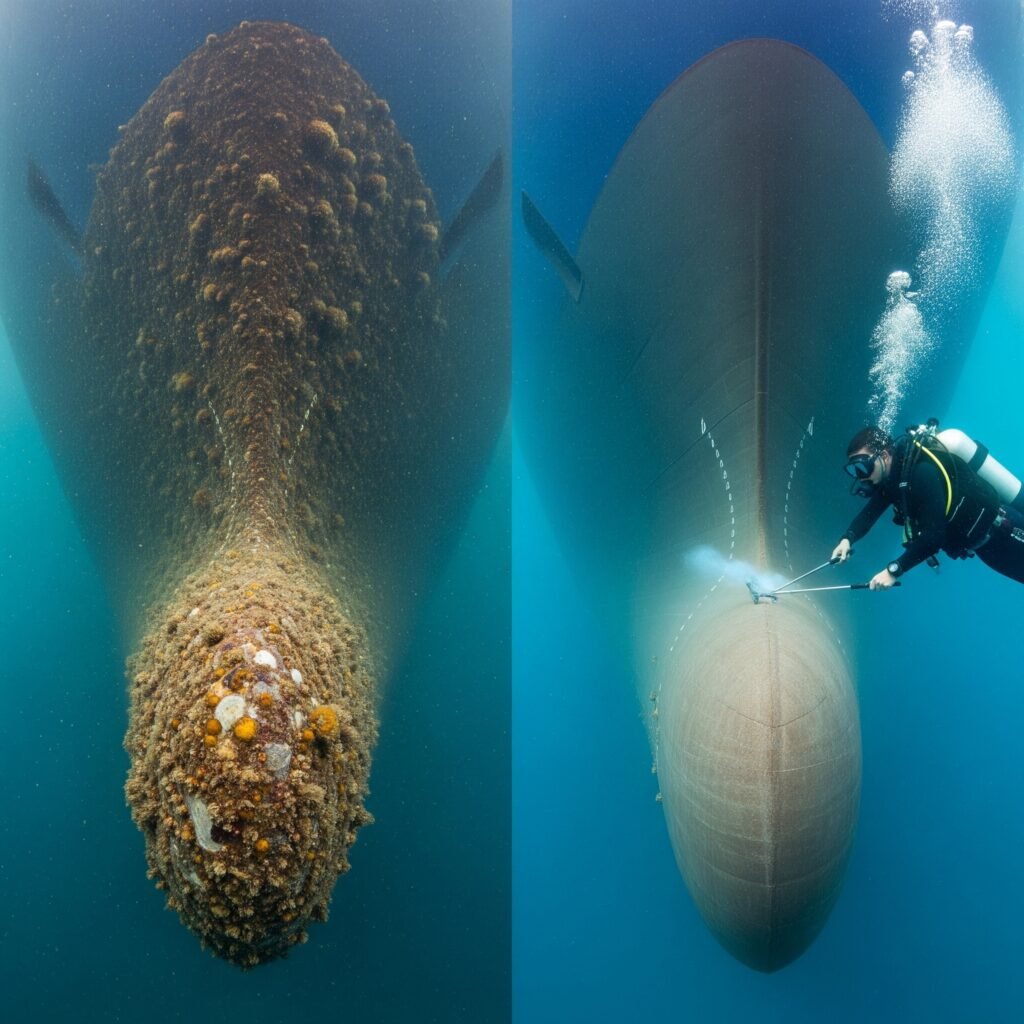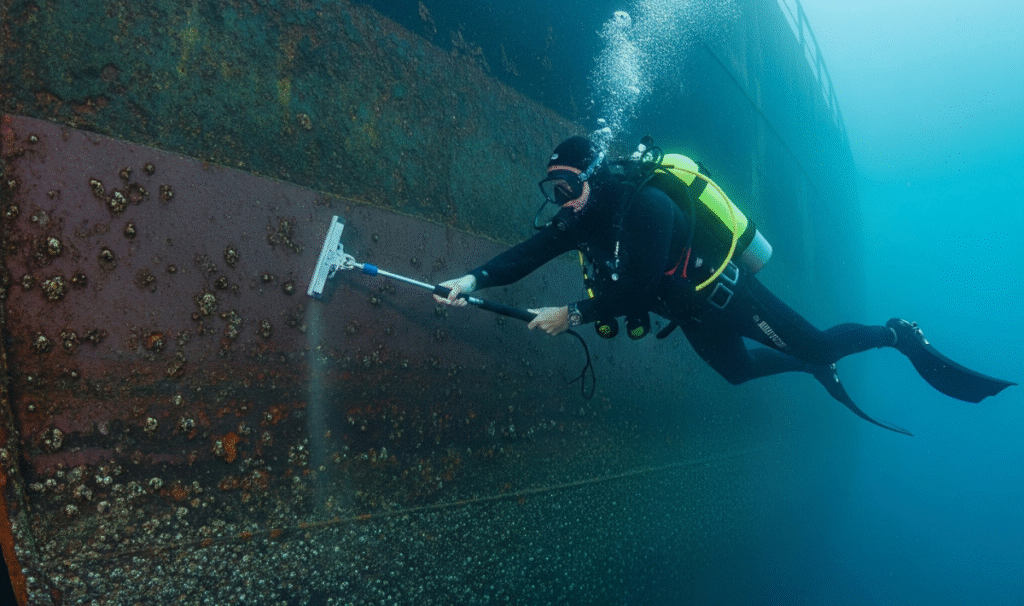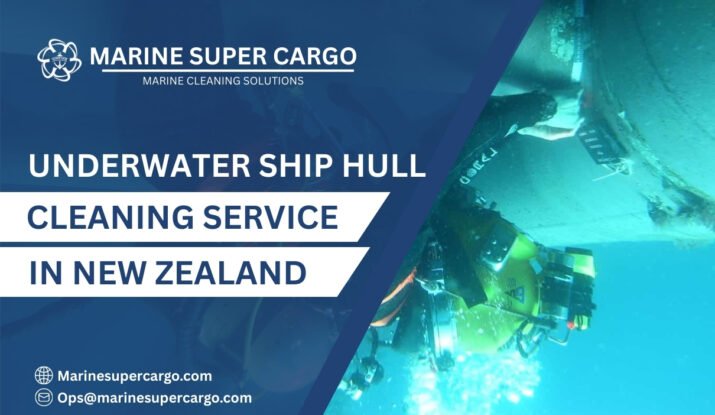When most people picture New Zealand, what comes to mind? Rolling green hills, world-class rugby, or majestic Lord of the Rings landscapes. Yet hidden beneath its turquoise harbors lies another story: a nation with one of the Pacific’s most strategic maritime presences.
Positioned between the South Pacific and trade routes linking Asia, the Americas, and Australia, New Zealand sees constant shipping traffic. Tankers, fishing fleets, and cargo vessels all dock here. And with them comes an important service vital to their performance: underwater ship hull cleaning in New Zealand.
Far from being just a “scrub,” this service saves money, improves safety, and helps protect marine environments. Let’s dive into the underwater ship hull cleaning in New Zealand that every vessel owner should know.
What is Underwater Ship Hull Cleaning in New Zealand?
Biofouling is the quiet enemy of ships. Organisms like barnacles, algae, and mussels cling to the hull of a vessel. Over months at sea, this growth creates a rough surface akin to dragging sandpaper through the water. The consequences? Slower movement, higher fuel consumption, and structural risks.
Hull cleaning tackles this problem underwater. Certified divers or robotic systems use specialized brushes, cavitation jets, and suction equipment to remove buildup while protecting protective hull coatings. In New Zealand’s pristine waters, experts carry out this process under strict environmental regulations, balancing efficiency with marine conservation.
The Hidden Impact of Biofouling
Imagine running a marathon with weights strapped to your ankles. That’s what a fouled hull does to a ship. Increased drag makes engines work harder, raising fuel consumption by as much as 40%. Given that fuel is one of the largest operational costs for shipping companies, this hidden drag eats profits fast.

How Hull Cleaning Saves Money on Voyages
Regular underwater ship hull cleaning in New Zealand removes drag-causing biofouling, cutting fuel costs significantly. Vessels glide faster, consume less energy, and complete voyages more quickly. In many cases, the cost of cleaning is recouped within just a few trips.
For shipping companies managing large fleets, these savings can scale into millions each year—making cleaning not just a maintenance necessity but a financial strategy.
Combatting Corrosion and Structural Risks
Marine growth keeps hulls damp 24/7, accelerating corrosion and eating away at protective coatings. Left unchecked, this can cause steel degradation and costly repairs.
By scheduling underwater ship hull cleaning in New Zealand, operators safeguard their vessels against premature wear and strengthen longevity. Clean hulls mean fewer structural risks and more reliable voyages.
Compliance with International Safety Standards
Shipping is one of the world’s most regulated industries. The IMO enforces safety frameworks to reduce risks at sea, while hull cleanliness is a part of meeting those requirements.
Ships arriving in New Zealand ports are regularly inspected. A fouled hull could mean failed safety checks, delays, or even fines. By keeping up with cleaning schedules, vessel owners ensure smooth sailing through compliance protocols.
Lowering Shipping’s Carbon Footprint
According to imo.org, shipping is responsible for nearly 3% of global greenhouse gas emissions. By increasing efficiency, underwater ship hull cleaning in New Zealand directly cuts CO₂ output. Every ton of fuel saved means tons of emissions prevented.
For a nation like New Zealand—famous for its commitment to protecting natural landscapes—sustainable shipping practices align with national values and international climate agreements.
Preventing the Spread of Invasive Species
The MARPOL Convention emphasizes controlling biological contamination via global shipping. Unwanted organisms hitching rides on hulls can invade new ecosystems and destabilize biodiversity.
This issue is particularly important for New Zealand. Its waters host delicate, unique marine species, many found nowhere else. Routine hull cleaning prevents invasive hitchhikers from disrupting this fragile balance.
Why New Zealand is an Ideal Location for Hull Cleaning
Strategic Position in the South Pacific
New Zealand’s ports—Auckland, Wellington, and Lyttelton—serve as crucial stops for trans-Pacific and Australasian shipping routes. Ships passing through can easily access professional underwater ship hull cleaning in New Zealand, without lengthy diversions from major trade corridors.
Skilled Marine Workforce and Infrastructure
Following best practices promoted by imca-int.com and iaphworldports.org, New Zealand’s marine service sector provides international-standard cleaning supported by advanced technology and skilled professionals.
The Process of Underwater Ship Hull Cleaning in New Zealand
Step-by-Step Cleaning Overview
- Assessment – Divers inspect hull conditions and note biofouling levels.
- Biofouling Removal – Brushes, suction devices, or cavitation tools remove buildup.
- Hull Polishing – Surfaces are smoothed for optimal hydrodynamics.
- Debris Filtration – Removed organisms are collected or filtered to prevent marine contamination.
- Final Inspection – Ensures coatings are intact and hull meets compliance.
Modern Tools and Technologies in Use
New Zealand is adopting innovations like remotely operated vehicles (ROVs) and underwater drones. Eco-friendly cleaning systems ensure biofouling is filtered and disposed of responsibly, protecting the local seabed and ecosystem.
Challenges and Considerations
Striking a Balance in Cleaning Frequency
Too frequent cleaning risks stripping protective coatings; too infrequent, and biofouling can spiral out of control. Most experts recommend underwater ship hull cleaning in New Zealand every 6–12 months, depending on routes and downtime.
Environmental Conditions Unique to New Zealand
New Zealand’s waters are biologically rich and also encourage marine growth. Ships sitting idle in local ports can foul quickly, underlining the need for consistent hull maintenance here.

The Future of Hull Maintenance in New Zealand
Eco-Friendly Coatings and Cleaning Methods
The future of hull maintenance is shifting toward greener solutions. Innovations such as biocide-free antifouling paints, UV-light coatings, and advanced scrubber systems are set to transform how cleaning is performed. With its strong eco-conscious reputation, New Zealand is well-positioned to embrace these sustainable technologies. By partnering with forward-thinking providers like CleanShip.co, shipowners can adopt eco-friendly practices that not only enhance efficiency and compliance but also protect marine ecosystems—ensuring a cleaner, greener future for shipping in New Zealand’s pristine waters.
AI and Robotics in Ship Maintenance
The future is digital. Imagine AI sensors continuously monitoring hull smoothness and notifying shipowners when fouling reaches a drag threshold. This tech, paired with aquatic cleaning robots, will make underwater ship hull cleaning in New Zealand faster, safer, and more sustainable.
Conclusion
A dirty hull is more than just an eyesore—it’s a ticking expense and environmental hazard. Clean hulls, on the other hand, mean smoother sailing, stronger ships, and greener oceans.
The underwater ship hull cleaning in New Zealand is simple yet powerful:
- It saves fuel and money by minimizing drag.
- It extends vessel lifespan and ensures compliance with safety regulations.
- It helps fight climate change and protect New Zealand’s fragile marine ecosystems.
For ship operators in the South Pacific, New Zealand offers world-class infrastructure, trained teams, and eco-sensitive practices. Hull cleaning here is not just maintenance—it’s a smart, sustainable investment in the future of shipping.
FAQ:
Q1. How often should underwater ship hull cleaning be done in New Zealand?
Typically, every 6–12 months, depending on vessel routes and local fouling rates.
Q2. Does hull cleaning damage vessel coatings?
Not when done professionally. Modern methods protect anti-fouling paints and coatings while removing biofouling.
Q3. Can hull cleaning really reduce carbon emissions?
Yes. By lowering drag, ships consume less fuel, which directly reduces greenhouse gas emissions.
Q4. Why is New Zealand a good place for hull cleaning?
Its location on global trade routes, skilled marine workforce, and eco-conscious practices make it highly suitable.
Q5. How does hull cleaning help protect marine ecosystems?
It prevents invasive species from spreading and reduces the release of pollutants, keeping local waters cleaner.


